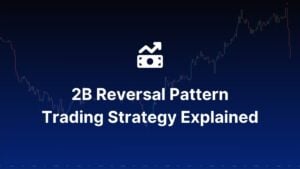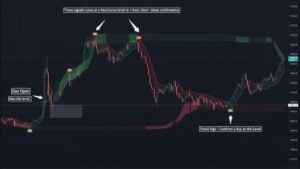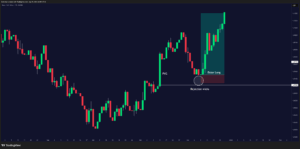Ever wonder how traders make money from the tiniest movements in the forex market? It is not sorcery and is not hard to figure out once you read about it.
This fast-paced trading approach focuses on making numerous small daily trades to take advantage of tiny price changes.
Scalping is a trading strategy that aims to profit from minor price changes and opening and closing positions in minutes or even seconds. It’s slipping in and out of trades before the market even realizes you were there!
Traders swap currencies by exploiting the minute price changes in highly liquid and volatile currency pairs. They often focus on pairs like EUR/USD, GBP/USD, or USD/JPY during peak trading hours when market activity is at its highest.
Forex scalpers typically hold positions for a few seconds to minutes, rarely longer than 15 minutes. The goal is to make numerous small daily profits, which can accumulate into significant gains.
Is forex scalping profitable?
Now for the million-dollar question: Can you make money with forex scalping?
The short answer is: Yes, it can be profitable. But (and it’s a big ‘but’), it’s not a guaranteed path to riches; to have your best chance at profits, you must look for strategies that have been proven to work.
Pros of Forex Scalping
Scalping can be lucrative because:
- You can accumulate small profits quickly, which can add up to significant gains over time.
- You’re not exposed to overnight risk since positions are closed within minutes.
- You can take advantage of the most liquid times in the forex market.
Cons of Forex Scalping
However, there are some serious challenges:
- Transaction costs can eat into your profits quickly due to the high frequency of trades.
- It requires intense concentration and can be mentally exhausting.
- You need a solid understanding of technical analysis and quick reflexes.
- A few bad trades can quickly wipe out a day’s worth of profits.
So, profitability in scalping often comes down to having a rock-solid strategy, iron discipline, and the right temperament. It’s surely not about getting rich overnight; forex scalping comes with being consistent for small gains that compound over time.
How to Scalp Forex?
- Choosing the Right Broker
Your broker is your gateway to the forex market, and in scalping, every millisecond counts. Look for:
- Ultra-low spreads and commissions
- Lightning-fast execution speeds
- A robust, responsive trading platform
- Appropriate leverage options (use judiciously)
Remember, a subpar broker can turn even the best strategy into a losing one. Take your time to research and select a broker that aligns with your scalping needs.
- Selecting Your Currency Pairs
Focus on major pairs known for their liquidity and tight spreads:
- EUR/USD: The king of forex pairs
- GBP/USD: Known for its volatility
- USD/JPY: Often moves in predictable patterns
These pairs have rapid price movements scalpers thrive on without the wide spreads that can eat into your profits.
- Develop Your Scalping Strategy
In scalping, your charts are your roadmap. Familiarize yourself with short-term timeframes:
I. 1-minute charts: For the most rapid scalping
II. 5-minute charts: For a bit more context
III. 15-minute charts: For a broader market view
Learn to read these charts like a pro. They’ll reveal opportunities invisible to the untrained eye.
Combine these indicators thoughtfully. They should complement your strategy, not complicate it. We’ll talk about some helpful indicators in the next bit.
Next, for your strategy, set some clear rules for:
- Entries: What precise conditions must be met?
- Exits: Both for taking profits and cutting losses
- Position sizing: How much to risk on each trade
Without solid rules, you’re trading on emotion – a recipe for disaster in the trading world.
Scalping can be an emotional rollercoaster. To stay on track:
- Stick to your predefined strategy, even during losing streaks
- Avoid the temptation of revenge trading
- Take regular breaks to maintain mental sharpness
Remember, consistency is key. The most successful scalpers are often the most disciplined.
- Risk Management
Robust risk management is non-negotiable:
- Use tight stop-losses to limit potential losses
- Aim for a positive risk-reward ratio, even on small moves
- Put a maximum daily loss limit to protect your account
It might seem restrictive, but it’s what allows you to trade another day.
As I’ve been mentioning throughout, in scalping, speed and accuracy are paramount:
- Learn your platform’s hotkeys for lightning-fast order placement
- Consider using one-click trading features if available
- Practice entering and exiting trades quickly and accurately
Remember, a second delay can be the difference between profit and loss in scalping.
Keep a detailed trading journal and document every trade:
- Entry and exit points
- The rationale behind the trade
- Market conditions
- Outcome and lessons learned
Consider your journal as your personal trading textbook. Use it to learn from both your successes and mistakes.
Handy Indicators for a Forex Scalping Strategy
- RSI
This momentum oscillator is incredibly useful, especially for lower time frames, like 5 or 15 minutes. It tells you when a currency pair is overbought or oversold. When the RSI line crosses above 70, it signals overbought conditions and suggests it might be time to sell. Conversely, dips below 30 indicate oversold conditions and signal a buying opportunity. When the RSI hits these levels, it’s your cue to act!
- Moving Averages
We’re not talking about the slow-moving averages here but the more responsive exponential moving averages (EMAs). The 5 and 13 EMAs are particularly popular among scalpers. Their crossovers can signal potential entry and exit points, helping you spot reversals quickly. The EMA’s responsiveness to recent price changes makes it invaluable for short-term trading decisions.
- Bollinger Bands
If you’re into technical analysis, Bollinger Bands are your best friend. These dynamic channels expand and contract with volatility, giving you a visual guide to potential breakouts and reversals. When the price touches the upper or lower band, it often signals a significant price move is coming. It’s like getting a heads-up before the market makes its next big move.
- Volume Indicators
Let’s not forget about Volume indicators, which are often overlooked. In forex trading, we look at tick volume. Spikes in volume can signal impending price movements, giving you the advantage of jumping in before everyone else. Keeping an eye on volume can give you that extra edge in making quick, profitable trades.
Time-Tested Strategies for Forex Scalping
- Moving Average Crossover Strategy
How It Works: Use two moving averages, such as a 50-period MA and a 200-period MA. When the shorter MA crosses above the longer MA, it’s a buy signal. When it crosses below, it’s a sell signal.
Why It Works: It identifies trend reversals and confirms the market’s direction. Scalpers use these crossovers to enter trades in the new trend’s direction.
- Bollinger Bands Strategy
How It Works: Trade based on the price touching the outer bands. Buy when the price touches the lower band and sell when it touches the upper band.
Why It Works: Bollinger Bands indicate volatility and help identify overbought and oversold conditions. Use the bands to predict short-term price reversals, entering and exiting trades quickly to capture small profits.
- Scalping with RSI
How It Works: Use the RSI to find overbought and oversold conditions. Enter trades when the RSI crosses the 70 or 30 levels.
Why It Works: The RSI is a reliable indicator for spotting potential reversal points and confirming trends. Scalpers use RSI to time their trades, buying at oversold levels and selling at overbought levels to capitalize on quick price movements.
- The 5-3-1 Strategy
The 5-3-1 strategy is the best strategy for Forex Scalping. Here’s how you can implement it:
- 5 Currency Pairs: Choose five currency pairs to trade. These should be pairs you understand well and have consistent liquidity and volatility.
- 3 Trading Strategies: Develop and refine three trading strategies. Each strategy should be tested and proven to work under different market conditions. You can then adapt to various market scenarios by having multiple strategies.
- 1 Trading Session: Focus on one trading session that fits your lifestyle and the currency pairs you’ve chosen. Consistency is key, so trading during the same session helps you better understand its nuances and patterns.
Best Time to Scalp in Forex
First things first, forget about a 9-to-5 schedule. The forex market has its own 24-hour schedule, but not all hours are equal.
- Market Overlaps: The most active trading period is typically during the London-New York overlap (8:00 AM to 12:00 PM EST / 1:00 PM to 5:00 PM GMT). This period often sees increased liquidity and tighter spreads, particularly for EUR/USD, GBP/USD, and USD/CHF pairs.
- Asian Session: The Tokyo open (around 7:00 PM EST / 12:00 AM GMT) can offer opportunities, especially for pairs involving JPY. The Sydney/Tokyo overlap (around 2:00 AM EST / 7:00 AM GMT) can also provide some trading opportunities.
- Mid-Week Activity: Tuesdays, Wednesdays, and Thursdays often see the highest market activity and liquidity, making them potentially more suitable for scalping than Mondays and Fridays.
- News Releases: Major economic announcements and central bank decisions can trigger volatility spikes. However, these periods also come with increased risk.
The key is to find your personal sweet spot. Test different times, keep a trading journal, and soon you’ll find your rhythm. Remember, the best time to scalp depends on your chosen currency pairs. If you’re trading EUR/USD, the European and North American sessions are your playground. For AUD/USD or NZD/USD, you might want to tune in during the Asian session.






